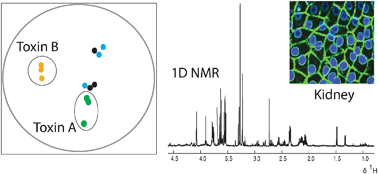Toxicity testing is vital to protect human health from exposure to toxic chemicals in the environment. Furthermore, combining novel cellular models with molecular profiling technologies, such as metabolomics can add new insight into the molecular basis of toxicity and provide a rich source of biomarkers that are urgently required in a 21st Century approach to toxicology. We have used an NMR-based metabolic profiling approach to characterise for the first time the metabolome of the RPTEC/TERT1 cell line, an immortalised non-tumour human renal epithelial cell line that recapitulates phenotypic characteristics that are absent in other in vitro renal cell models. RPTEC/TERT1 cells were cultured with either the dosing vehicle (DMSO) or with exposure to one of six compounds (nifedipine, potassium bromate, monuron, D-mannitol, ochratoxin A and sodium diclofenac), several of which are known to cause renal effects. Aqueous intracellular and culture media metabolites were profiled by 1H NMR spectroscopy at 6, 24 and 72 hours of exposure to a low effect dose (IC10). We defined the metabolome of the RPTEC/TERT1 cell line and used a principal component analysis approach to derive a panel of key metabolites, which were altered by chemical exposure. By considering only major changes (±1.5 fold change from control) across this metabolite panel we were able to show specific alterations to cellular processes associated with chemical treatment. Our findings suggest that metabolic profiling of RPTEC/TERT1 cells can report on the effect of chemical exposure on multiple cellular pathways at low-level exposure, producing different response profiles for the different compounds tested with a greater number of major metabolic effects observed in the toxin treated cells. Importantly, compounds with established links to chronic renal toxicity produced more diverse and severe perturbations to the cellular metabolome than non-toxic compounds in this model. As these changes can be rationalised with the different pharmacological and toxicity profiles of the chemicals it is suggested that metabolic profiling in the RPTEC/TERT1 model would be useful in investigating the mechanism of action of toxins at a low dose.

You have access to this article
 Please wait while we load your content...
Something went wrong. Try again?
Please wait while we load your content...
Something went wrong. Try again?


 Please wait while we load your content...
Please wait while we load your content...